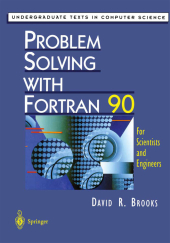 Neuerscheinungen 2012Stand: 2020-01-07 |
Schnellsuche
ISBN/Stichwort/Autor
|
Herderstraße 10
10625 Berlin
Tel.: 030 315 714 16
Fax 030 315 714 14
info@buchspektrum.de |

David R. Brooks
Problem Solving with Fortran 90
For Scientists and Engineers
Softcover reprint of the original 1st ed. 1997. 2012. xxxiv, 682 S. 216 SW-Abb. 254 mm
Verlag/Jahr: SPRINGER, BERLIN 2012
ISBN: 1-461-27353-6 (1461273536)
Neue ISBN: 978-1-461-27353-0 (9781461273530)
Preis und Lieferzeit: Bitte klicken
The author shows how using computers and FORTRAN 95 it is possible to tackle and solve a wide range of problems as they might be encountered in engineering or in the physical sciences.
´1. Computing Environments for Problem Solving.- 1.1 A Brief History of Electronic Computing.- 1.1.1 The First Generation.- 1.1.2 The Second and Third Generations.- 1.1.3 The Fourth Generation.- 1.2 The Academic Computing Environment.- 1.2.1 The Department-Based Computing Environment.- 1.2.2 The Personal Computing Environment.- 1.3 What Do You Need to Know About Your Computing Environment?.- 1.4 Fortran and the Personal Computing Environment.- 1.5 Is Programming Necessary Anymore?.- 1.6 Exercises.- 2. Solving Problems with a High-Level Programming Language.- 2.1 Structured Programming and Problem Solving.- 2.1.1 A High-Level Programming Language Provides the Tool.- 2.1.2 Developing a Formal Approach to Problem Solving.- 2.1.3 Beware of Logical Errors.- 2.2 Designing Algorithms for Procedural Programming Languages.- 2.2.1 Getting Started.- 2.2.2 Executable Instructions.- 2.2.3 Data Types and Variables.- Data types.- Variables.- 2.2.4 Designing Algorithms for Solving Problems.- Defining a pseudocode language.- The three basic program control structures.- Adding to your pseudocode vocabulary.- Flowcharts: another way to visualize algorithms.- 2.3 Program Modularization.- 2.4 Applications.- 2.4.1 Maximum Deflection of a Beam Under Load.- 2.4.2 Oscillating Frequency of an LC Circuit.- 2.5 Debugging Your Algorithms.- 2.5.1 Algorithm Style.- 2.5.2 Problems with Your Algorithms.- 2.6 Exercises.- 2.6.1 Self-Testing Exercises.- 2.6.2 Basic Algorithm Development Exercises.- 2.6.3 Algorithm Development Applications.- 3. Getting Started with Fortran: Writing Simple Programs.- 3.1 A Simple Problem and a Fortran Program to Solve It.- 3.2 Program Layout.- 3.2.1 What Is "Source Code?".- 3.2.2 Where Does Source Code Come From?.- 3.2.3 Why Do the Fortran Statements All Start in Column 7?.- 3.2.4 Inserting Comments in Source Code Files.- 3.2.5 How Much of P-3.1 Is Absolutely Necessary and How Much Is a Matter of Style?.- 3.2.6 Fortran Keywords.- 3.2.7 What If a Statement Is Too Long to Fit on a Single Line?.- 3.2.8 Executable and Nonexecutable Statements.- 3.3 Declaring Variables and Defining Constants.- 3.3.1 Variable Names and Data Type Declarations.- 3.3.2 Intrinsic Data Types.- Type declarations for intrinsic data types.- Type declarations for numbers.- Type declarations for logical variables.- Type declarations for characters and strings of characters.- The PARAMETER attribute and statement.- Enforcing explicit typing.- The implications of type declaration.- Using nonexecutable statements in programs.- 3.3.3 Constants.- Integers and real numbers.- Logical constants.- Character constants.- 3.3.4 Initializing Values with the DATA Statement.- 3.4 List-Directed Input and Output.- 3.4.1 Reading and Displaying Numerical Values.- Displaying a prompt for user input.- Getting input from the keyboard.- Displaying output.- 3.4.2 Manipulating Text Information.- 3.5 Arithmetic Operators, Assignment Statements, and Calculations.- 3.5.1 Arithmetic Operators, Expressions, and the Assignment Operator.- 3.5.2 Assignment Statements That Increment Variables.- 3.5.3 Mixed-Mode Calculations.- 3.5.4 Using Compatible Constants.- 3.5.5 Operator Precedence.- 3.6 Program Termination.- 3.7 Compiling and Executing a Program.- 3.7.1 Source Code Portability.- 3.7.2 Compilation and Execution.- 3.7.3 Saving Output from Your Programs.- 3.8 Applications.- 3.8.1 Maximum Deflection of a Beam Under Load.- 3.8.2 Relativistic Mass and Speed of an Electron.- 3.9 Debugging Your Programs.- 3.9.1 Programming Style.- 3.9.2 Your Programs Will Often Contain Errors.- 3.9.3 Some Common Errors.- Compilation Errors.- Execution Errors.- Logical Errors.- 3.9.4 Forcing Your Programs to Fail.- 3.10 Exercises.- 3.10.1 Self-Testing Exercises.- 3.10.2 Basic Programming Exercises.- 3.10.3 Programming Applications.- 4. Using Functions to Expand the Power of Fortran.- 4.1 Fortran Intrinsic Functions.- 4.


